Eco-Friendly Interstate Moving: Sustainable Practices to Consider
February 7, 2024
Moving interstate can have a significant environmental impact if not done consciously. From packing supplies and fuel consumption to waste generation, a move presents many opportunities to reduce your carbon footprint. Here’s an overview of some eco-friendly practices to consider when coordinating an interstate move:
The beginning stages of planning an interstate move present chances to go green. Opting for reusable moving boxes, padding, and supplies cuts down on waste. Taking inventory and purging unneeded items also reduces the move’s environmental impact through transporting less.
Fuel usage is another major factor during a long-distance relocation. Selecting an eco-conscious moving company that offsets emissions, uses biodiesel, and plans the route efficiently can significantly reduce carbon output. Renting a fuel-efficient truck and driving conservatively can also lower fuel consumption.
Waste disposal and recycling properly at the old and new homes plays an integral role in sustainable moving. Donating unwanted goods, composting, and using electronic documents instead of paper throughout the relocation process reduces environmental harms.
With some planning and effort, interstate moves can adopt planet-friendly practices. Applying eco-conscious principles during packing, transport, fuel use, and waste disposal enhances sustainability.
One of the best ways to make your interstate move more eco-friendly is to reduce waste. Start by choosing reusable moving boxes and packing materials whenever possible. Look for used boxes from local businesses, friends, or moving container companies. Used boxes are inexpensive or free and prevent additional cardboard waste.
For padding and wrapping, opt for reusable materials like old towels, linens and blankets rather than buying new bubble wrap or packing paper. Using what you already have on hand cuts down on excess. If you do need to purchase packing supplies, look for plastic-free, compostable options made from recycled materials.
Also be mindful of how you pack. Pack efficiently to avoid empty space which requires more filler. And don’t overpack boxes which can lead to damage and waste. Sturdy, evenly packed boxes with minimal empty space are less likely to break open or require additional boxes during your move.
Carefully planning your packing and intentionally reducing waste is one of the most meaningful ways to make your interstate move greener. Using reusable materials saves money while also keeping additional waste out of landfills.
Moving across states inevitably involves a lot of driving. For eco-friendly moves, it’s important to conserve fuel whenever possible.
Optimizing routes is one of the best ways to minimize miles driven during a move. Interstate Moving companies should use route planning software and GPS to determine the shortest and most fuel-efficient routes. Drivers should avoid taking unnecessary detours or making extra stops that add unnecessary mileage. Companies can train drivers on practices like progressive shifting and avoiding jackrabbit starts and stops to conserve gas.
Planning the loading of the moving truck carefully can also help reduce fuel consumption. Distributing weight evenly throughout the truck is ideal for fuel efficiency. Loading the truck from front to back, keeping heavier items low, and avoiding empty space also helps optimize fuel usage. Companies should provide training on properly loading trucks to conserve gas.
Simple practices like avoiding idling, maintaining proper tire pressure, removing extra weight, and traveling at moderate speeds can also help trucks maximize miles per gallon. Every step moving companies take to conserve fuel on interstate trips helps reduce the carbon footprint.
When selecting a moving company, consider one that uses electric or hybrid vehicles. This reduces the carbon footprint of your move by relying on vehicles that run on electricity rather than gasoline.
Electric and hybrid moving trucks are becoming more common as companies aim to reduce their environmental impact. Though they may have a higher upfront cost, electric vehicles save money over time through reduced fuel and maintenance costs. And better yet, they emit far less air pollution compared to diesel-powered moving trucks.
Some moving companies are even taking bigger steps by incorporating solar panels on their storage facilities to generate renewable energy. This powers their daily operations in a sustainable way.
Ask potential moving companies about their sustainability practices like electric vehicles and solar power. Favor companies making serious investments to reduce their carbon footprint. This ensures your interstate move will have less impact on the environment.
Going with a green moving company is an easy way to make your relocation more eco-friendly. The miles you’ll be traveling will be powered by clean electricity rather than fossil fuels.
When moving across states, it’s easy to accumulate things you no longer need or want. Often these unwanted belongings end up in the landfill.
An eco-friendly alternative is to recycle or donate items you no longer use. This keeps them out of landfills and allows your unwanted possessions to find new life with someone else.
Here are some tips for green disposal when moving:
– Go through all your belongings and make three piles – keep, donate, and recycle. Be ruthless in deciding what you really need going forward.
– Research local donation centers that accept clothing, furniture, electronics, household items, and more. Schedule a free pickup or drop off items yourself.
– Check if any items can be recycled, like batteries, paint cans, plastic containers, and more. Use local recycling facilities.
– Sell quality furniture, electronics, or other valuables through second hand stores. You make extra cash while passing items on sustainably.
– Compost any food scraps or yard waste rather than sending it to landfills. Some communities offer composting services.
– Properly dispose of hazardous waste like chemicals, CFL bulbs, gasoline, etc. Check guidelines and facilities in your area.
Green disposal takes more time and effort than simply tossing things. But it dramatically reduces your environmental impact from moving. With some planning, you can give nearly everything a sustainable second life.
Going paperless is one of the easiest ways to make your interstate move more eco-friendly. Printing documents uses resources and energy, so reducing paper waste is a great sustainability goal.
Do digital paperwork instead of printing whenever possible. Download forms and fill them out electronically. Scan important documents to store them digitally instead of keeping paper copies. Sign documents electronically where allowed.
Set up digital systems to reduce paper use. Use cloud storage instead of filing cabinets. Go paperless with billing by opting for electronic statements instead of mailed paper bills. Automate payments to avoid printing checks.
If you need to print, be strategic about it. Print double-sided to use both sides of the paper when possible. Choose recycled paper with eco-friendly inks. Set printers to draft mode to use less ink. Collect and recycle used paper instead of trashing it.
Minimizing paper use saves trees and reduces waste. Going paperless takes some effort to set up initially, but it pays off through long-term sustainability gains. Consider going paperless for your next interstate move to reduce your environmental impact.
One way to make your interstate move more sustainable is by using eco-friendly cleaning products to prepare your home. When getting your house ready for the move, avoid harsh chemical cleaners which can pollute waterways. Instead, look for plant-based, non-toxic cleaning solutions.
Vinegar, baking soda, lemon juice, and other pantry staples can often replace conventional cleaners. Check labels and aim for products certified by third parties like Green Seal that meet environmental standards. They will get the job done without heavy duty chemicals.
Using green cleaners reduces your carbon footprint and creates a healthier home environment. It also prevents noxious runoff that impacts ecosystems. With some simple swaps, cleaning can be better for families and the planet.
When packing for an eco-friendly move, consider using recyclable packing materials. Many moving companies now offer recyclable packing peanuts made from cornstarch or other biodegradable materials. These dissolve in water, reducing waste.
Reusable packing blankets and quilts are another option, eliminating disposable padding like styrofoam. Look for companies that will collect and reuse these on future moves.
For paper packing like tissue paper and bubble wrap, try to source recycled-content options. Using recyclable kraft paper to wrap items is better than plastic bubble wrap. Shredded paper makes great homemade packing material too.
When sealing boxes, skip the plastic tape which isn’t recyclable. Use paper tape made from recycled content instead. It sticks boxes closed while remaining environmentally friendly.
With some creativity and research into sustainable packing methods, you can make your interstate move much more eco-friendly. Proper packing not only protects your belongings but also reduces unnecessary waste.
When moving long distances, especially across multiple states, the amount of emissions produced can be significant. One way to help reduce the environmental impact is by purchasing carbon offsets.
Carbon offsets allow individuals and companies to invest in environmental projects around the world that reduce greenhouse gas emissions. The projects supported include renewable energy, forest conservation, and more. Each offset represents a certain reduction of CO2, measured in tons.
For an interstate move, calculate the estimated mileage and emissions produced. Then use a carbon offset calculator to determine the amount needed to offset those emissions. There are many reputable companies that provide carbon offset services. The investment helps counteract the carbon footprint of the move.
Offsetting emissions is an easy, affordable way to take responsibility for the environmental impact of an interstate relocation. While efficiency measures can reduce emissions, offsets help balance out the remaining carbon footprint. They support sustainability initiatives that otherwise may not be funded. Overall, carbon offsets are a simple yet meaningful step toward moving in a greener, more eco-conscious way.
Moving to a new home in another state can be an exciting yet stressful time. As you prepare for your interstate move, it’s important to consider how you can make the process more eco-friendly and sustainable.
Throughout this article, we’ve covered several ways you can reduce your environmental impact when moving long distance:
– Reduce waste by reusing moving boxes and materials, buying recycled products, and avoiding excess packaging. Plan ahead to donate, recycle, or compost any waste.
– Conserve fuel in the moving truck by loading it efficiently, combining trips, and driving at moderate speeds. Look into carbon offset programs to mitigate emissions.
– Use green energy and low-emissions transport whenever possible. Opt for rail or electric vehicles over gas-guzzling trucks.
– Dispose of chemicals, batteries, paints, and other hazardous materials properly to avoid pollution.
– Go paperless by using digital copies and cloud storage instead of printing documents. Share files electronically.
– Use non-toxic, eco-friendly cleaners and detergents for packing and cleaning the old and new homes.
– Pack with reusable containers and biodegradable packing peanuts. Avoid excess packaging materials.
– Offset the carbon emissions of your move by supporting renewable energy or reforestation projects. Every bit helps.
With some planning and extra care, you can have an eco-friendly interstate move and reduce your environmental footprint. Keep these green practices in mind for a more sustainable relocation.
Moving to a new place can be an exciting adventure, but it often comes with a considerable environmental footprint. The process of packing up your life and transferring it to a different location typically involves the use of various packaging supplies, many of which can be harmful to the environment. Fortunately, there’s a better way. In this guide, we’ll explore eco-friendly packaging supplies and sustainable moving practices that can help you make your move more environmentally responsible. From biodegradable moving boxes to green packing materials, we’ve got you covered.
Sustainable packaging is a solution that takes into consideration the environmental impact of the materials used in packing, shipping, and transporting goods. It aims to minimize waste, reduce the use of harmful chemicals, and prioritize materials that can be recycled or reused. When it comes to moving, adopting sustainable packaging practices can significantly contribute to a greener, more eco-conscious process.
Eco-friendly packaging offers numerous advantages, not only for the environment but also for you as a mover. Here are some of the benefits:
To embark on an eco-conscious move, you need the right supplies. Let’s explore some of the sustainable moving supplies that can make your transition to a new home more environmentally responsible.
One of the easiest ways to reduce waste during a move is to use biodegradable moving boxes. These boxes are typically made from materials that break down naturally, leaving no lasting impact on the environment.
Tip: Choose biodegradable moving boxes for your next move to minimize waste and support environmentally friendly practices.
Opt for recyclable packing materials such as cardboard and paper for wrapping and cushioning your items. These materials can be easily recycled after your move, reducing their environmental impact.
Consider using sustainable tape options like paper tape or water-activated tape made from biodegradable materials. These alternatives are just as effective as traditional plastic tape but have a lower environmental impact.
Tip: Make a conscious choice to use sustainable tape to secure your packages and minimize your use of single-use plastics.
When it comes to eco-friendly moving boxes, consider using boxes made from recycled materials. These boxes have already served a purpose and are given a second life, reducing the need for new resources.
Choose renewable packing tape made from materials like kraft paper or plant-based adhesives. These options are not only effective but also kinder to the environment.
As you or your packing company packs for your move , here are some tips to help you maintain eco-conscious practices:
Consider using eco-friendly moving container options like plastic totes that are designed for multiple uses. These containers are sturdy and can be used for various purposes beyond your move.
Opt for moving truck rentals from companies that prioritize sustainability by using fuel-efficient vehicles or those powered by cleaner fuels.
Tip: Look for moving truck rental companies that follow eco-friendly practices to reduce your carbon footprint during your move.
Adopting a minimalist approach to packing is another eco-conscious strategy. By packing only what you truly need and letting go of unnecessary items, you can significantly reduce waste and minimize your environmental impact.
In conclusion, embracing Eco-Friendly Packaging Supplies is not only possible but also essential for reducing your environmental footprint during your move. By choosing sustainable moving supplies, minimizing waste, and making eco-conscious decisions, you can have a successful move while maintaining a commitment to the environment.
Are you ready to embark on an eco-friendly move that aligns with your values and supports a more sustainable future? Explore our tips for sustainable moving and traveling to ensure your move is not only hassle-free but also environmentally responsible..
All counts when it comes to sustainability.
Making your daily habits greener will lead to a major impact over time, but embarking on big projects and monumental changes with an environmental perspective at the forefront of your thoughts is just as critical.
For example, Americans produce 4.51 pounds of municipal solid waste per person per day, according to the Environmental Protection Agency. Perhaps you’ve reduced the amount of discretionary products you eat, decreasing your daily average. If you can fill an entire dumpster with your garbage come moving day, it will not do any good.
You might be thinking about how you can avoid any might pitfalls if you’re getting ready to move this year. Eco-friendly steps include creating less landfill waste and reducing the carbon footprint.
Here are the tips for keeping you on track for a change that is sustainable.
Chances are, it won’t take you by surprise if you have a move coming up. But get started early to stop filling garbage bags in a panic when the moving van turns up. You’ll have a lot of advance notice.
Next, recognize objects that you do not use anymore. You can host a yard sale with enough preparation time to find good homes for your used goods and scrape together a little extra cash. You can give away or donate large-ticket items, too. In your town, there might be family members or even charities who will gladly bring bulky giveaways themselves.
Recycle anything you can’t sell or donate. Trashing something needs to be the last resort.
Letting perishable food build up in your fridge is one common mistake. In the last few weeks leading up to the transfer, slow down your grocery shopping and spread out what you’ve got by tossing it in the freezer.
Also Read: Unpacking Guides: What Essential Items to Unload First When You Moved?
Start by reusing boxes from your last move when it comes to preparing for your eco-friendly move if you saved them. Sustainable movers should consider searching for used cardboard boxes or storage crates as a second step, which are distributed or sold by local businesses on the cheap.

Second, by using towels, comforters, blankets, and other natural cushions from around the house to fill the empty space in your boxes, rather than looking for foam peanuts, pack wisely. As with our first suggestion, if you start early, this piece of advice is easier to achieve.
Opt for compostable, biodegradable, or otherwise reusable containers and packing materials when everything else fails.
There are some things that you can do on your own, but moving isn’t a solitaire game. You’re definitely going to need help with certain aspects of the process at least.
Find a transitional business that values sustainability as much as you do. They can do a great deal to mitigate your move’s environmental effects.
If you’ve hired a moving company, for example, they can map lower-impact routes, drive in an environmentally friendly way, and decrease the time they spend idling, which alone is no small matter. Currently, the Energy Department reports that 6 billion gallons of fuel are lost annually by idling heavy-duty and light-duty vehicles.
Related Articles:





